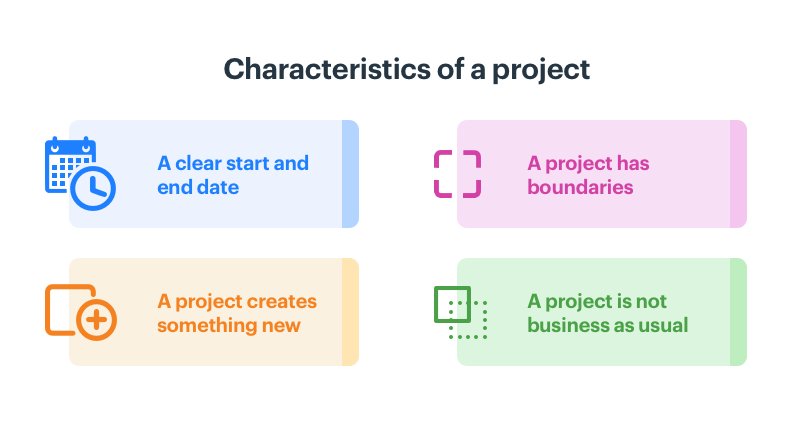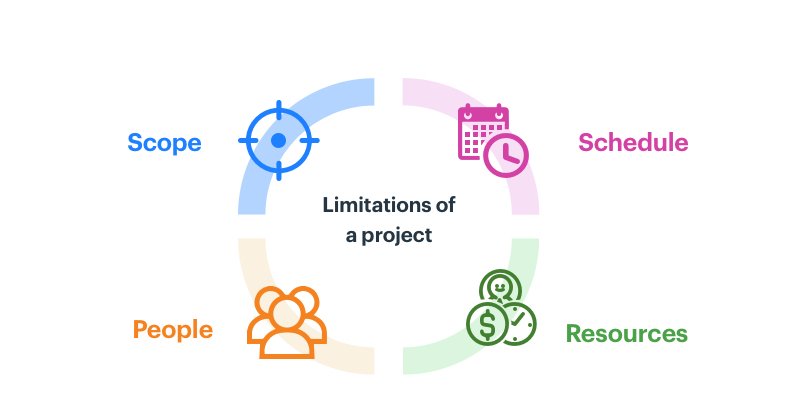
What is Project Management?
Characteristics of a project

- A clear start and end date – There are projects that last several years but a project cannot go on forever. It needs to have a clear beginning, a definite end, and an overview of what happens in between.
- A project creates something new – Every project is unique, producing something that did not previously exist. A project is a one-time, once-off activity, never to be repeated exactly the same way again.
- A project has boundaries – A project operates within certain constraints of time, money, quality, and functionality. We’ll see more about this in later sections.
- A project is not business as usual – Projects are often confused with processes. A Process is a series of routine, predefined steps to perform a particular function, say, expense reimbursement approvals. It’s not a one-off activity. It determines how a specific function is performed every single time.
The diverse nature of projects
A project can:
- Be big : Like the construction of the Hoover Dam, take years to complete, and have a humongous budget.
- Be small : Like your weekend project of installing a pathway in your lawn
- Involve many people : Like planning a wedding
- Just yourself : rearranging the photos in your wedding album
Types of projects
Projects can be diverse in the ways in which they are implemented. Here are some examples of projects:
- Traditional projects : These are run sequentially in phases. These phases are typically initiation, planning, execution, monitoring, and closure. Most high-cost infrastructure projects make use of traditional project management.
- Agile projects : These are used mainly in software development. They are people-focused and adaptive. They also typically have short turnaround times.
- Remote projects : Remote project management is usually used by distributed teams that seldom meet in person. Handling freelance contributors is an example of a remote project.
- Agency projects : Agency projects are outsourced to an agency that is likely to have projects with multiple clients. Marketing and design projects are commonly outsourced to agencies
The boundaries of a project
Every project operates within certain boundaries called constraints :
- Project scope
- Project schedule
- People
- Resources.

All of these project constraints depend on what the project aims to achieve and when. The outcome of a project results in deliverables. Anything that’s produced during the project’s development such as documents, plans, and project reports is considered a deliverable. A deliverable may also be the result of the project itself.
Having a final deliverable, as well as a finite timespan, distinguishes project management from business-as-usual operations. Since projects are unlike routine operations, most people involved are those who usually don’t work together. Sometimes, the professionals involved will come from different organizations and geographies. If the desired outcome is achieved on time and within budget, a project is considered to be a success.
Project life cycle – 5 stages
1. Initiation
The first phase in a project’s life cycle is called project initiation. Here, a project officially launches. It is named, and a broad plan is defined. Goals are identified, along with the project’s constraints, risks, and shareholders. At this point, shareholders decide if they want to commit to the project.
Depending on the project, studies may be conducted to identify its feasibility. For IT projects, requirements are usually gathered and analyzed during the initiation phase.2. Planning
3. Execution
The project plan is implemented during the project execution phase. At this point, teams will work on the deliverables to ensure that the project meets the necessary requirements.
Everyone usually gathers for a meeting to mark the official start of the project, where teams can get acquainted with each other and discuss their roles in the success of the project. Modes of communication and project management tools are identified before the project plan is executed.4. Monitoring and Controlling
The project monitoring and controlling phase happen at the same time as the execution phase. It’s the job of the project manager to oversee operations and make sure that everything is headed in the right direction, according to plan.
Aside from overseeing the project’s performance, project managers have to monitor resources, manage risks, head status meetings, and reports, etc. If unforeseen issues arise, the project manager may have to make adjustments to the plans, as well as the project schedule.5. Closing
When is a project considered a success?
The short of it is that a project that is completed on time and on a budget can be considered a success. However, a project can be evaluated on many criteria:
- Does it meet business requirements?
- Is it delivered on schedule and on a budget?
- Does it deliver the expected value and ROI?
How to implement a project
Project implementation can vary based on the methodology used. In traditional project management, implementation is done in 5 phases.
- Initiation : This phase involves making the case for the project to convince the project stakeholders. A Project Initiation Document (PID) is created with basic information about the project including probable resource use and feasibility.
- Planning : This phase occurs once a project has received approval from stakeholders. This is a critical phase that involves a myriad of tasks including contingency planning, allocating tasks, and planning resource sharing.
- Execution : This is the phase when the actual work happens. Periodical reviews are conducted to ensure that execution happens within schedule.
- Monitoring : Monitoring happens in tandem with execution. Constant monitoring by the project manager is required to ensure that work goes on minus hiccups.
- Closure : This phase involves the important final tasks in the project including project delivery to the client and documenting the learnings from the project
How project management helps you manage projects
Projects can be very complex undertakings that require a huge amount of effort and resources. No matter what the goal is, using project management principles will help the initiative run smoothly. Without proper project management principles, projects will be handled haphazardly and are at a much higher risk of
- project failure,
- delay in the project, and
- being over budget.
